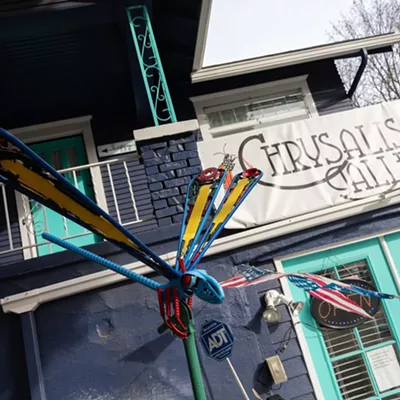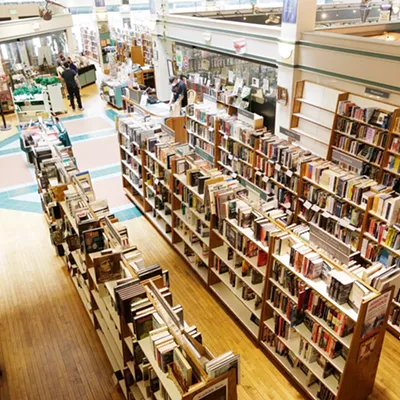You might want to bring a folding chair to artist Dick Schindler's latest exhibition, "Backside Storage Unit," at Kolva-Sullivan Gallery through March 31. There's a lot to absorb: Twenty years worth of mixed media drawings, paintings, sculpture and assemblages, and nearly all of it abstract enough that you'll want to sit with it a bit and let its stories unfold.
Start at the industrial Adams Street gallery's entry wall, which is covered in a giant oval of individual mixed media images, like an organized explosion of ideas. Some images resemble technical drawings of animals and mechanical apparatus. Others channel the canon of art history: Goya, Francis Bacon, Picasso, Paul Klee, but also Frank Lobdell, a leader in the Bay Area figurative and abstract expressionist movements, and under whom Schindler studied.
The work in "Backside Storage Unit" is a small fraction of Schindler's 60-year journey with art and the result of a steadfast morning ritual: a cup of coffee and drawing materials.
"It's almost irritating because I have piles and piles and piles [of stuff around me], but I always have something going on, something I'm working on," says the 82-year-old Schindler. He's still blown away by the power of making marks on paper, and "the idea that you can just play with something and imagine."
Schindler remembers liking to take things apart while drawing as a youngster. Early works prompted his father to sign him up for art lessons.
"My mother thought I was going to be an archaeologist," says the now-retired college instructor whose stints included Eastern Washington University and Spokane Falls Community College. "My teachers thought I was going to be an architect."
Instead, Schindler left home in Harrisburg, Pennsylvania, for the Marines, enamored with the idea of overseas travel. Before the lead-up to the Vietnam War, however, Schindler returned home. He briefly attended York College and got married (after a divorce, Schindler wed fellow artist and college art instructor Lena Lopez Schindler). The mid-1960s saw Schindler in San Francisco working in sales for a chemical distributor. Yet, as before, he felt pulled elsewhere.
"I walked into the San Francisco Art Institute, and I could not believe I saw large paintings and sculptures being made," he recalls. "And that was it — I felt like I found home."
The Bay Area was a hotbed of intellectual and artistic activity at the time. It rivaled New York in terms of influential artists and art movements, from photographer Annie Leibovitz to painters Richard Diebenkorn and Clyfford Still, the latter hailing from Spokane.
Schindler remembers having a visceral reaction to Still's abstract expressionist works when he first saw them at the San Francisco Museum of Art.
"I felt like I was witnessing some sort of powerful spirit," he says.
In turn, his contemporaries and other modernists impacted how Schindler made art. While working in his studio, there was "a strange kind of conjuring experience going on, traveling in the work and discovering," he recalls.
The joy of discovery and learning is not limited to art. While at the San Francisco Art Institute, Schindler says content experts from nearby Berkeley University would visit — physicists, social scientists, even English literature professors.
"God, it was amazing," he says. "You could hang out and talk about anything under the sun."
In 1971, Schindler was pursuing a master's of painting at nearby Stanford University, and he remembers touring the university's linear accelerator, a theoretical and experimental research facility. The topic still fascinates him (he segues into a recommendation for a physics documentary, Everything and Nothing: The Amazing Science of Empty Space), including "how we envision the universe, how we deal with light and particles and the changes in that field."
After Stanford, Schindler landed in Roswell, New Mexico, attending the prestigious Roswell Artist in Residency. That experience nurtured his experimental side — a year just making stuff, he says — and cemented his desire to stay in the West.
While living and teaching in California, Schindler heard more and more about North Idaho. It was the '70s and the lure of adventure combined with rising California real estate prices that prompted him to move to Bonner County, where he built his own house.
His neighbors in an area known as Beyond Hope were Ed Kienholz and Nancy Reddin Kienholz, an internationally known pair of assemblage artists collectively referred to as Kienholz. Schindler became friends with the couple, who had similar views about working with objects.
"Like, you call it junk," Schindler says. "I call it art making materials because I see the potential," describing how his and his neighbors' overflowing garages (and sheds and storage units) inspired the exhibition's title, "Backside Storage Unit."
Around when Ed Kienholz died in 1994, Schindler recalls reading about the stages of death in Tibetan Buddhism. He remembers Ed appearing in a dream, encouraging him to keep making art.
"It was really powerful," says Schindler, who also paraphrases artist Paul Klee's idea of the "artist as transmitter."
Schindler points to "Polish," one of the largest paintings in the exhibition and the frontispiece for its publicity. It honors his mother and led to his researching Slavic folk art, sensing some kind of ancestral voice driving his mark making.
"Why am I driven to do the pattern, to go back in and keep developing it?" he asks rhetorically.
At some point, he says, it's as if he hears the word "stop" and knows a piece is done. Even so Schindler admits he couldn't help himself from "tinkering" with the painting.
"That was dangerous," he says, smiling. "Not knowing when to stop, that's a really difficult thing." ♦
Backside Storage Unit • Through March 31, by appt. • Free • Kolva-Sullivan Gallery • 115 S. Adams St. • Facebook: Kolva-Sullivan-Gallery • 509-458-5517
























